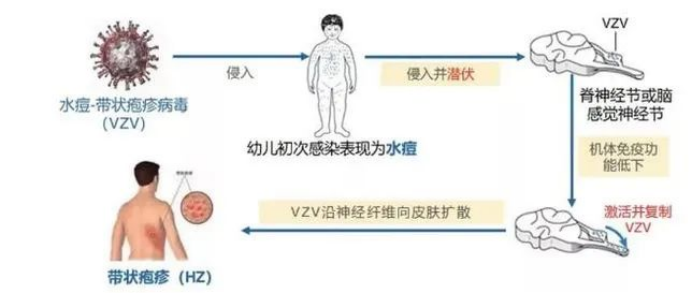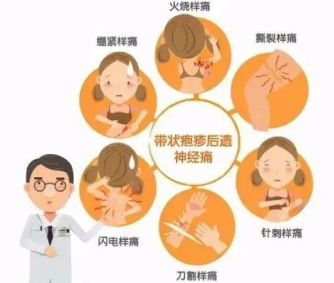[Micro Popular Science] Herpes Zoster in the Elderly
Every time the seasons change, the elderly are prone to a disease, see a string of blisters in the waist, and the site of the disease is as painful as acupuncture, fire, and even the pain can not sleep, change what body posture is useless. The pain can range from days to months. Folk called "snake wrapped around the waist", what is this disease?
Etiology and pathogenesis
The disease, called shingles, is an acute infectious skin disease caused by the varicella-zoster virus (VZV). The elderly population is the most common population, and shingles in people over 60 years old is called "senile shingles". When the virus first infects humans, it lurks in the posterior root ganglion of the spinal cord or the sensory ganglion of the cranial nerve. When the human immunity is reduced, such as when the elderly are tired, cold, suffering from certain chronic diseases such as diabetes, cardiovascular disease, etc., or mental stress is too much, the virus will be activated again, along the sensory nerve fibers move to the skin, causing herpes in the corresponding nerve innervation area, and accompanied by pain.

clinical picture
Some older people may have some prodromal symptoms before the rash. For example, local skin may feel burning, tingling, or itching.
The typical rash is a cluster of papules and blisters on the basis of erythema, the walls of the blisters are tense and shiny, the blister fluid is clarified, and the periphery is red. The skin between blisters is generally normal. The rash is usually distributed along the nerves, in bands, and does not extend beyond the midline of the body. After a few days, the blisters will gradually dry up and form a scab, which usually leaves a temporary reddish spot or pigmentation. Herpes zoster skin lesions usually resolve within 2 to 3 weeks after appearance, but it takes 3 to 4 weeks or even longer for elderly herpes zoster skin lesions to resolve.

Pain is a prominent symptom of shingles, especially in older people. The nature of the pain can vary, including pinprick, electric shock, knife cut or burning pain. Some elderly people feel the pain is so intense and unbearable that it can even interfere with sleep and daily life. The pain can occur before or at the same time as the rash, and may persist up to 3 months after the rash has subsided, a condition called postherpetic neuralgia. The incidence of postherpetic neuralgia in the elderly is relatively high and may last for months or even years. It is often accompanied by anxiety, depression, moderate to severe sleep disorders, elevated blood pressure and weight loss, which seriously affect patients' physical and mental health and quality of life, and can even lead to suicide.

In addition, we also need to be wary of some specific types of shingles, which can be seen at any age, but are more common in older patients and have more severe and complex symptoms. There is only neuropathic pain in the whole course of herpes zoster, and no rash appears all the time, which is called herpes zoster without eruption. If there is only a red rash or maculopapular rash, no blister formation is called aborted zoster; Herpes zoster involving the head and face, such as eyes, ears, and nose; The rashes are widely distributed, with ≥ 20 typical shingles rashes outside the primary and adjacent cutaneous segments, ≥ 3 cutaneous areas involved, or visceral involvement, referred to as disseminated shingles. A rash that crosses the midline is called bilateral shingles.
heal
Elderly herpes zoster clinical symptoms, more complications, greater harm to the elderly, so once found suspicious symptoms, should be timely to the regular hospital dermatology treatment, rapid control of the condition, in order to alleviate acute pain, shorten the duration of skin lesions, reduce the occurrence of posthumous neuralgia, promote rehabilitation. Common treatments include:
1. Antiviral therapy: Early and adequate antiviral therapy is very important to shorten the course of the disease, reduce pain and prevent complications. Commonly used antiviral drugs include acyclovir, valaciclovir and famciclovir. It should be used within 72 hours of the appearance of the rash for best results.
2. Pain treatment: For the elderly with obvious pain, drugs can be used to relieve the pain. Non-steroidal anti-inflammatory drugs such as ibuprofen can be used for mild pain relief. For moderate to severe pain, drugs such as gabapentin and pregabalin may be used, which can reduce nerve pain by regulating neurotransmitters. Elderly patients have a high risk of adverse reactions, and the use of analgesic drugs needs to be monitored. For patients with persistent pain that cannot be tolerated, minimally invasive interventional therapy such as nerve block and nerve regulation or pain department assistance can be considered.
3. Nutrient nerve treatment: Drugs such as vitamin B?, Vitamin B?? can be used to nutrient nerves and promote nerve repair, such as mecobalamine.
4. Local treatment: calamine lotion can be used. If the blister is ruptured, wet compress with 3% boric acid solution can be used to reduce seepage and prevent infection. When there is a secondary infection, topical antibiotic ointment, such as mupirocin ointment, can be applied.
5. General treatment: pay attention to rest, avoid fatigue, quit smoking and alcohol, relieve anxiety and stress, ensure adequate sleep, balanced diet, help maintain immune function and disease recovery.
preventive measure
Getting the shingles vaccine is one of the most effective ways to prevent shingles. The current shingles vaccine can effectively reduce the risk of developing shingles in the elderly and reduce the symptoms after the onset of the disease.
In addition, the elderly can strengthen their body's immunity through proper exercise, maintain good lifestyle habits such as regular work and rest, balanced diet, and prevent infection, and try to avoid contact with chickenpox or shingles patients, especially at the stage when their blister fluid is infectious.
In short, once the onset of herpes zoster in the elderly, the symptoms are often severe, which seriously affects the quality of life of patients. It is necessary to make a clear diagnosis as soon as possible, give efficient and reasonable antiviral, anti-inflammatory, analgesic and other treatments, shorten the course of the disease, reduce complications and the occurrence of related syndromes such as posthumous neuralgia, and promote the physical and mental rehabilitation of patients.
Li Weiran, the First Affiliated Hospital of Anhui Medical University
Young member of Dermatology Branch of Chinese Geriatric Society
(The opinions expressed are solely those of the author. Some pictures in this article are from the Internet, if there is infringement, contact delete)

